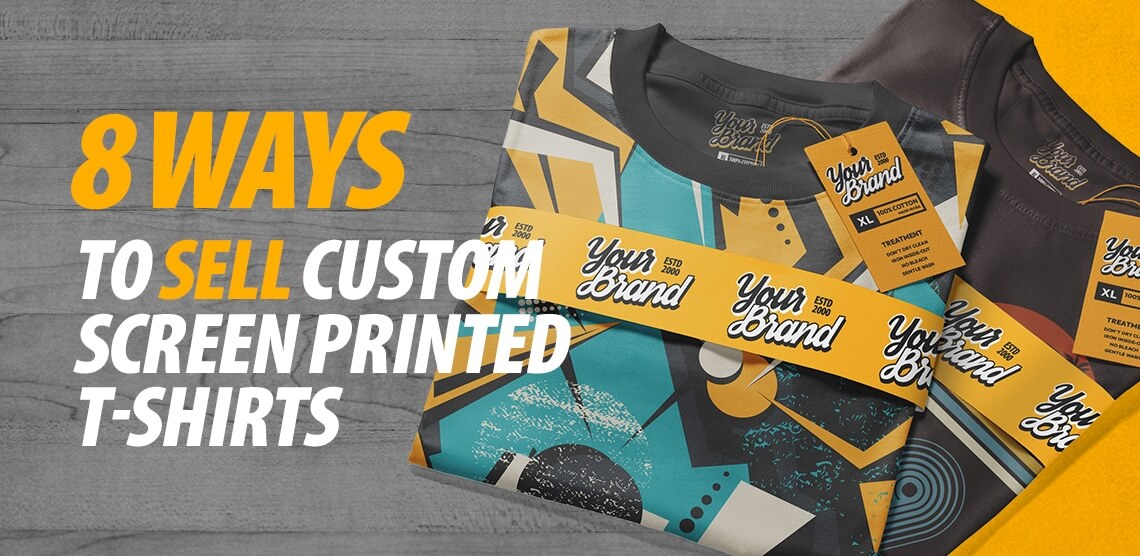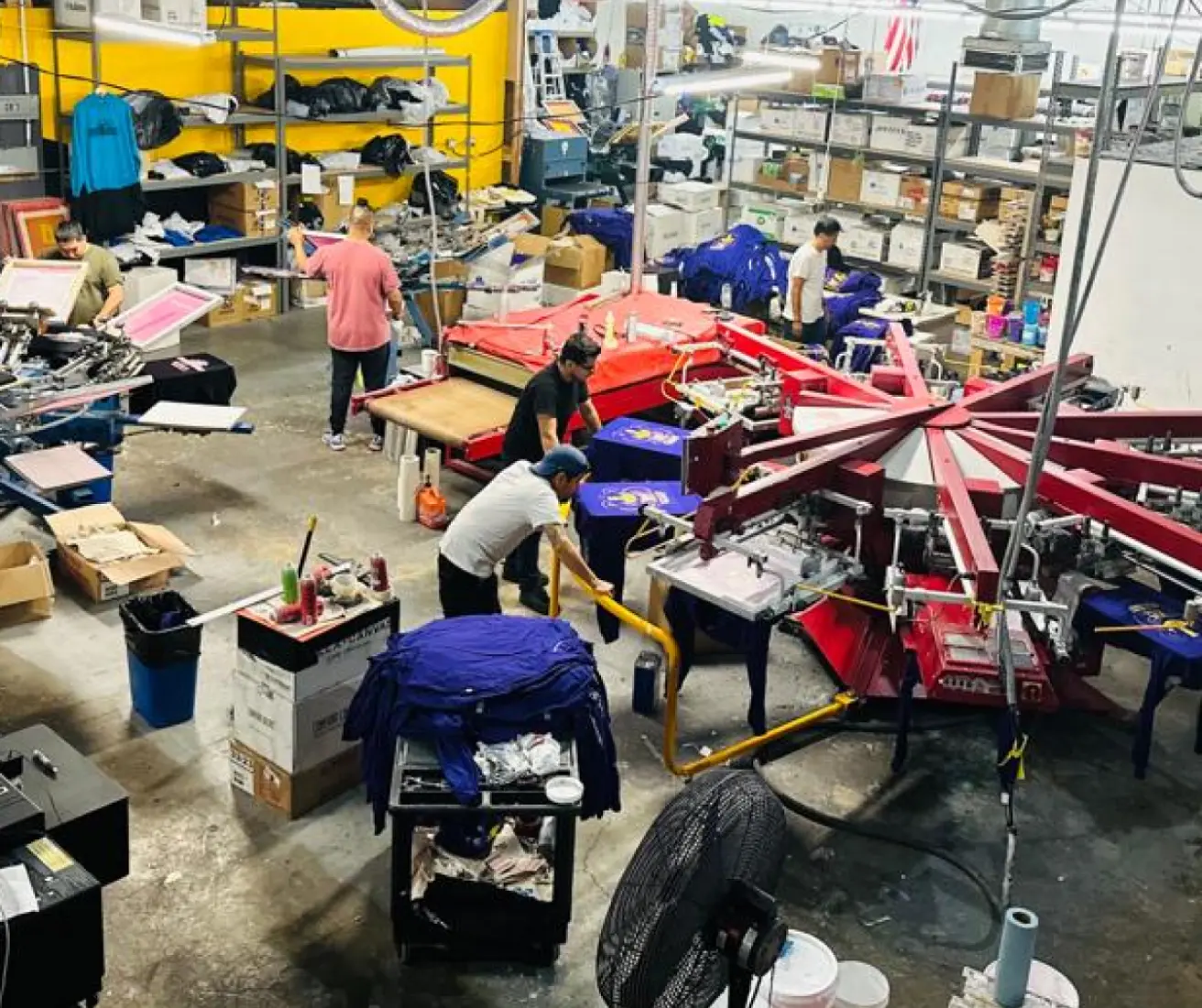Display Printing Uncovered: Whatever You Required to Learn About Tee and Garment Printing Strategies
If you have actually ever asked yourself just how those dynamic layouts wind up on your favorite tee shirts, you're in the ideal area. Display printing is a remarkable approach that combines art with technique, offering limitless opportunities for imagination. Recognizing the principles, from devices to ink choices, can substantially influence your outcomes. Ready to discover the crucial components that make screen publishing an art form? Allow's reveal the details that can boost your projects.
The Fundamentals of Screen Printing: Just How It Functions
When you dive right into display printing, you'll uncover it's both a science and an art. At its core, display printing involves producing a pattern, or screen, that allows ink to pass through only in details locations (screen printing kit). You start by choosing your style and preparing your screen with a light-sensitive emulsion. When you expose this emulsion to light, it sets, leaving your design as a negative area.
Next, you'll mix your inks and prepare your printing surface area. Placement the screen over the fabric, then use a squeegee to press ink with the display onto the garment. This process needs precision, as you desire clear, vivid prints. After printing, you'll cure the ink with heat, ensuring it sticks to the material and lasts through cleans. Each action is necessary, and understanding them will raise your display printing skills, transforming straightforward garments into special, expressive items.
Kinds Of Screen Printing Methods
As soon as you grasp the fundamentals of display printing, it's time to discover the different strategies that can raise your layouts. One prominent technique is traditional screen printing, where ink is pushed through a stenciled display.
If you're going for fine details, take into consideration discharge printing. This technique gets rid of color from the textile, leaving a soft, vintage look. Another option is plastisol printing, understood for its toughness and vibrant shades, making it a favorite for several brand names. Ultimately, try out halftone printing to produce gradient results and detailed styles. Each technique has its distinct charm, so do not hesitate to try them out to find what matches your style best!
Important Tools for Display Printing
To achieve magnificent outcomes in screen printing, having the appropriate devices is fundamental. You'll need a tough display printing structure, which holds the mesh that moves your design onto the garment. Next off, spend in top notch mops; these are vital for applying ink uniformly throughout the screen.
Picking the Right Inks and Products
When picking inks and products for display printing, you require to think about the kind of ink that works ideal for your job. Consider textile compatibility to assure your designs look great and last long. Also, discover environment-friendly ink alternatives to make your printing procedure much more sustainable.
Sorts Of Display Inks
Picking the ideal display ink is necessary for attaining dynamic, durable prints that satisfy your job's demands. There are numerous types of screen inks to examine. Specialty inks, such as glow-in-the-dark or metal, can add distinct impacts to your layouts.

Textile Compatibility Factors To Consider
Comprehending material compatibility is important for accomplishing premium screen prints, specifically considering that various materials respond distinctly to different inks. Constantly evaluate your inks on sample material to guarantee they stick properly and keep shade integrity. In addition, maintain in mind that material weight and structure can affect the final result, so picking the best ink and product combination is important for your task's success.
Eco-Friendly Ink Options
Green inks are becoming a preferred selection for screen printers that want to reduce their ecological influence while maintaining quality. When picking inks, consider water-based inks, which are less unsafe and simpler to clean up compared to traditional solvents.
Additionally, seek inks made from sustainable sources, such as soy or vegetable-based choices. By selecting the best inks and products, you'll not only create stunning designs however additionally add to a more sustainable printing process. Make the switch, and your prints will show your dedication to the setting!
Preparing Your Layout for Display Printing

File Layout Requirements
To assure your style looks sharp and vivid on textile, you'll require to pay attention to submit layout demands for screen printing. Start with vector data like AI or EPS, as they can be scaled without losing top quality. If you make use of raster photos, select high-resolution data, such as TIFF or PNG, ideally at 300 DPI. Prevent utilizing JPEGs, as they can shed clarity when resized. Make certain your layout has a transparent history to stop undesirable white edges on your prints. Maintain shade modes in mind; CMYK is standard for screen printing, so convert your RGB makes appropriately - screen printing kit. By complying with these guidelines, you'll establish your art work up for a successful print.
Shade Separation Techniques
Shade splitting up is an important action in preparing your layout for screen printing, and mastering it can substantially improve your print high quality. You'll require to damage your layout right into individual colors, as each color calls for a different screen throughout printing. Begin by identifying all the colors in your layout and develop layers each. You can make use of software like Adobe Photoshop or Illustrator to isolate and separate shades efficiently. Be particular to save each layer as a separate data, normally in a layout like TIFF or PSD. This precision this link not just ensures accurate shade representation yet likewise simplifies the printing process. By focusing on shade splitting up, you'll attain expert and vivid results in your screen-printed garments.
Resolution and Dimension
Accomplishing the very best cause display printing starts with learn this here now assuring your layout has the ideal resolution and dimension. Ideally, your art work ought to be at least 300 DPI (dots per inch) for sharp, clear prints. If you utilize reduced resolution, your end product may look amateur and pixelated.
When it comes to size, consider the dimensions of your print area. Layout your art work to match the last print size, ideally developing it in the real dimensions you'll be publishing. In this manner, you'll avoid any unanticipated scaling concerns.
Always examine your style in both vector and raster layouts. Vector graphics can be scaled without losing high quality, making them suitable for display printing. Preparing correctly will guarantee your layout looks fantastic on every garment!
Step-by-Step Screen Printing Refine
Display printing is a dynamic procedure that enables you to develop vibrant styles on various surfaces. To get going, you'll need a screen, emulsion, and your selected ink. Initially, prepare your screen by cleaning it completely. Next, use the emulsion evenly and allow it completely dry in a dark location. Once dry, reveal your display to light with your style put on it, which will set the solution where the light hits, producing a stencil - screen printing kit.
After rinsing the unexposed emulsion, your screen is prepared. Set it up on your printing surface area and align your garment under it. Pour ink onto the screen and utilize a squeegee to press the ink via the stencil onto the material. Lift the screen thoroughly and let the print completely dry. Lastly, heal the ink using heat to guarantee toughness. That's it! You have actually efficiently screen published your layout.
Tips for Successful Display Printing Projects
While you're diving into your screen printing projects, bear in mind that preparation is vital to success. Beginning by collecting all your materials-- inks, garments, mops, and screens. A tidy work space assists protect against unwanted errors, so tidy up prior to you start.
Next, confirm your artwork is high-resolution and appropriately sized for your garment. Test your screen for appropriate exposure and tidy it completely to avoid spots. When blending your inks, adhere to the maker's standards to achieve the appropriate uniformity.
During printing, use even stress with your squeegee for consistent results. Don't rush; take your time to verify each print fulfills your requirements. After printing, let your garments dry entirely prior to handling or packaging them.
Finally, constantly maintain an example of your job for future referral. In this manner, you can analyze your development and enhance your techniques in time. Happy printing!

Frequently Asked Concerns
Just how Lengthy Does It Take to Establish a Display Printing Task?
Setting up a display printing work usually takes about 30 mins to an hour. You'll prepare the screens, mix inks, and change journalism. The moment varies based upon complexity and experience, so stay organized!
Can I Publish on Different Material Keys In Using the Same Method?
Yes, you can publish on various textile kinds utilizing the very same strategy, however you'll require to readjust your settings and inks. Some textiles soak up ink differently, so exploring warranties the very best results read this for every product.
What Are Typical Blunders to Avoid in Screen Printing?
When display printing, avoid common mistakes like utilizing the wrong ink, overlooking correct exposure times, or missing pre-press checks. Always check your setup and preserve clean screens to guarantee quality results each time.
Just How Can I Appropriately Tidy and Preserve My Screen Printing Equipment?
To effectively tidy and maintain your display printing equipment, you ought to routinely wash screens with ideal solvents, check squeegees for wear, and ensure all tools are stored dust-free and dry. Consistency enhances and stops costly repair work efficiency.
Is Display Printing Ecologically Friendly Contrasted to Other Techniques?
Display printing can be extra eco-friendly than various other approaches, especially if you utilize eco-conscious materials and water-based inks. By selecting lasting products and practices, you decrease waste and reduce your influence on the planet.
Screen Printing Uncovered: Whatever You Required to Know Concerning Tee and Garment Printing Methods
At its core, display printing involves developing a pattern, or display, that enables ink to pass through just in certain areas. Setting the screen over the material, then utilize a squeegee to push ink with the screen onto the garment. One popular method is conventional display printing, where ink is pressed through a stenciled screen.When selecting inks and products for screen printing, you require to take right into account the kind of ink that works finest for your job.